BioE GAMES Camp Uses Cyborg Theme to Introduce High School Girls to Bioengineering
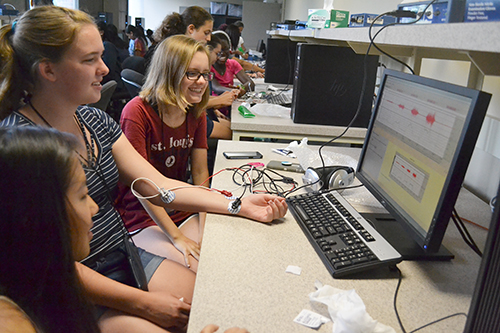
2018 Bioengineering GAMES campers do a muscle strength lab activity.
June 28, 2018
Cyborgs! Most of the 24 high school girls who participated in the Bioengineering GAMES (Girls’ Adventures in Math, Engineering, and Science) camp from June 17–23, 2018, had no doubt seen movies about them: human beings, like Wolfman of the X-Men, whose physical abilities have been extended beyond normal human limitations via mechanical elements built into their bodies. But the girls’ adventure during the week-long, BioE GAMES camp wasn’t just the stuff of sci-fi movies. They were introduced to some of the real science behind the notion. But participants were not only exposed to a variety of opportunities available to bioengineers. As they rubbed shoulders with role models who look like them—both female and an African-American— they were also exposed to the idea that they, too, could be Bioengineers Plus, they discovered what it might be like to be BioE student or even a medical student at Illinois.
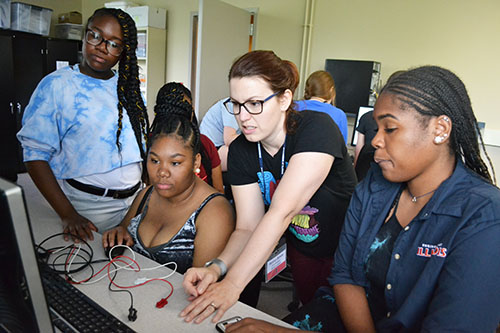
Jenny Amos (center) works with several Bioengineering GAMES campers on a lab activity.
This year’s BioE GAMES camp had a bit of a different look. While some of the experiments and activities were the same as in previous years, the camp director, Bioengineering Associate Professor Jenny Amos, also added some new things this year. She explains that because Bioengineering was set to move to its new location in Everett Hall, a lot the equipment wasn’t around. “So I had to be really innovative this year,” she admits, “and think about ways to use what we have available.” So, in keeping with some of BioE’s research emphases, this year's theme was cyborgs.
“Which is very fitting for Bioengineering,” she acknowledges, “because we get to talk about ways that Bioengineering is really pushing what it is to be human, and how we can repair or replace and regenerate different parts of the body to make even superhumans!”
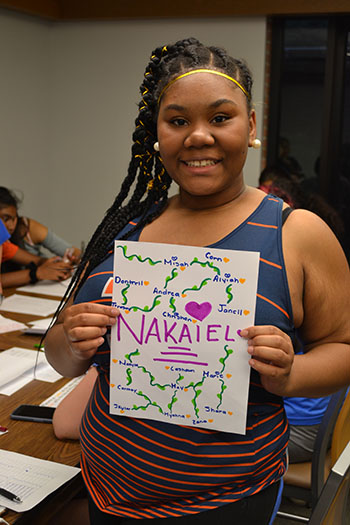
A BioE GAMES camper shows off the networking diagram she made during the evening Anthropology activity.
In light of the theme, during the camp, the girls participated in lectures, demonstrations, and lots of hands-on activities on related research currently taking place in BioEngineering: 3D printing, muscle control, biomimetics, and sight sensors; they even explored biobots and discussed ethics issues surrounding them. Also, campers took an all-day field trip to the JUMP Simulation Education Center in Peoria, Illinois. At this simulation and training center for doctors, campers saw how bioengineering affects medicine. Plus they got to practice life-saving techniques themselves and learn about the anatomy of animals by examining up close the heart and lungs of a pig.
The girls were also given the option to be participants in an extracurricular evening Anthropometry activity related to Dr. Kathryn Clancy and Dr. Carla Hunter's research. The goal was to help them understand what it's like to be research participants and also to help them make ethical decisions should they one day complete research.
While the goal of the camp is to use activities designed to pique the girls’ interest in Bioengineering, Amos says the thing she most loves about the camp is that she’s empowering women to do STEM. And she’s succeeding: some of these young women are choosing engineering. Some of them are even coming to Illinois.
“Every year,” she admits, “I look through my admissions for BioEs, and I find a few girls who used to do GAMES camps.”
And when she interacts with them, she says, “A lot of them say that's what motivated them to actually join Bioengineering and to come to school here—the GAMES camp experience.”
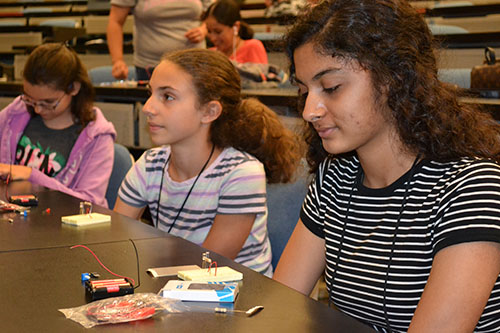
BioE GAMES campers do an activity about sight sensors.
Amos, who’s been running the Bioengineering GAMES camp for eight years, says that while she’s eased out of some of the other summer camps she’d been running, GAMES is too important. “But never GAMES, ‘cause GAMES is so special to me.”
So what's the benefit of bringing high school girls onto campus? According to Amos, who says BioE used to do a camp comprised of science activities targeting middle school girls, they changed their emphasis to high school girls because they’re on the cusp of making choices about college and career goals. For these young women, “Being on campus is a whole other experience,” she explains. “Being able to interact with current college students and college professors really helps fuel their, ‘Ok, I can do this; I can go to college; that could be me some day.’"
Plus, in addition to getting more girls in general into BioE, the camp was also exposing more girls of ethnicity to the discipline. Amos indicates that they’ve been specifically targeting girls of color.
“We try to maintain at least 30% underrepresented within the camp,” she explains, “and it's something we are really passionate about. Our camp, in particular, likes to talk about differences in race and gender in science.”
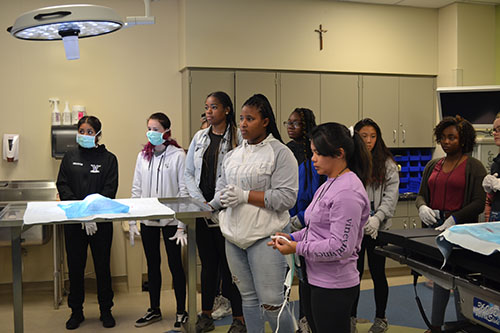
BioE GAMES high school students during a tour of the JUMP center in Peoria.
She adds that having an all-girl camp is, “A great opportunity to talk about women in science, and the climate around women in science which has been in the news a lot lately. So that's something that we openly talk about here in camp, and tell these girls, ‘Hey, you can do it. You're going to be the one who changes the way that science treats women.’"
To underscore that women can do science, Amos had a number of female BioE graduate and undergraduate students helping with activities, who also served as role models. The lone male among her assistants was Gabriel Burks, a BioE post doc who works for Amos. Though a male, he too, as an African American in STEM, served as a role model so the girls of color in the camp could see an African-American in science.
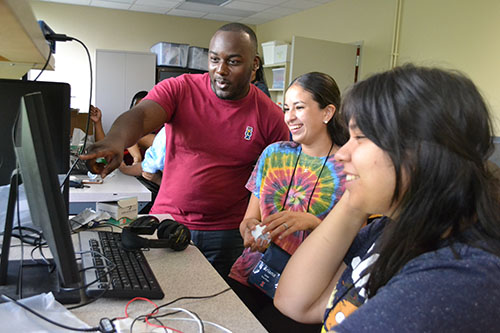
BioE postdoc Gabriel Burks works with GAMES campers doing a muscle strength activity.
Burks loves that he’s serving as an example for young women of color. “Yes, I think it’s inspiring for me to have the opportunity to share my face and to hopefully be of inspiration to students of color like myself. I think assimilation is most definitely a strong tool to get others to follow in their footsteps in that pathway.”
Like Amos, Burks also sees GAMES as a great way to recruit more women into STEM: “Oh this camp is an awesome opportunity to inspire the next generation of ladies to be scientists, technologists, engineers.”
Having just arrived on campus recently, Burks was excited to be involved. “This is my first year here with GAMES, and I’m jumping right in. It’s a lively experience, a lot of energy; it’s exciting for me to have the opportunity to work with a new camp, new institution, and a new community.

A BioE GAMES participant places sensors on another student's arms during the muscle strength activity.
Excited to be able to do the BioE GAMES camp every year, Amos considers it her own mini BioE pipeline for girls.
“The girls are amazing and it really helps inspire me to see all these girls coming every year and how excited they get, and it really helps keep my own kind of motivation going because I see them being exciting and then they end upcoming here to bioengineering, and then it's like this cycle of happiness.”
Story and photos by Elizabeth Innes, Communications Specialist, I-STEM Education Initiative.
More: 8-12 Outreach, BioE, GAMES, GAMES: BioE, Summer Camp, Women in STEM, 2018
For additional I-STEM articles about BioE G.A.M.E.S. camp, see:
- BioE GAMES Campers Are Exposed to Bioengineering, Engineering's Grand Challenges, & Encouraged to Stay in STEM (2017)
- G.A.M.E.S. Campers Learn about Bioengineering While Breaking Down Stereotypes (2016)
- G.A.M.E.S. Campers Experience Bioengineering—and Have Fun (2013)
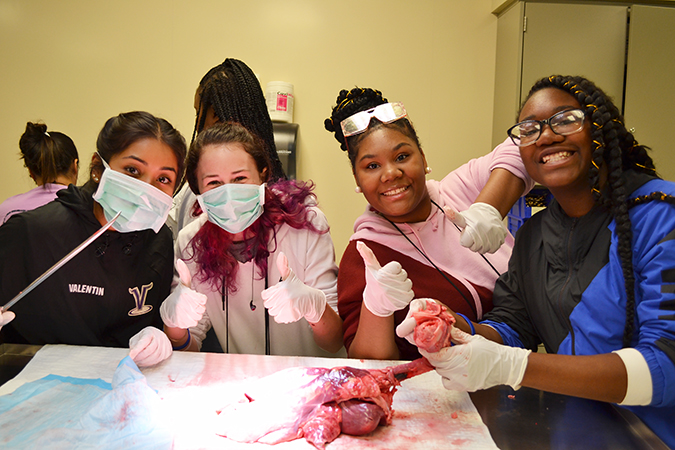
GAMES campaers find out a bit about what being a surgeon might be like as they get up close and personal with a pig's heart and lungs.













.jpg)
















